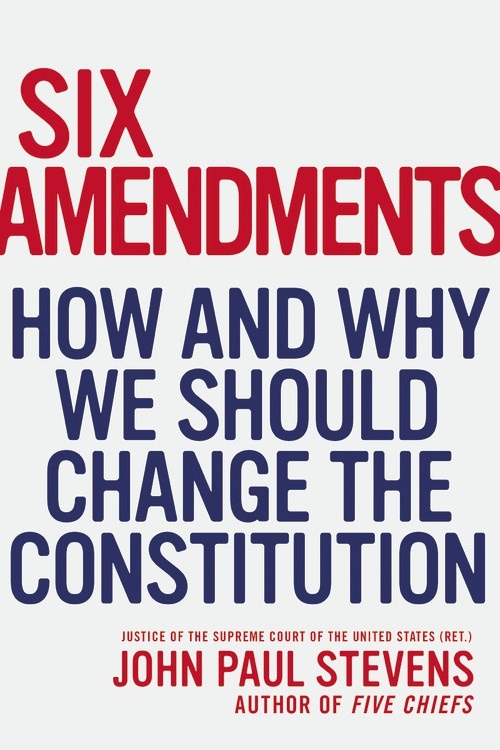 Constitutional law has always been a game of semantics. So it’s a pleasure to discover that former Supreme Court Justice John Paul Stevens’s new book, Six Amendments: How and Why We Should Change the Constitution (Little, Brown, 2014), is so clear in expression and purpose. For many, in these ultra-partisan times, this slight yet impressive book may not tip any balances. But few could find much to criticise in Stevens’s clean, thorough, economical style. Reading Six Amendments is like being taken in hand by the best tour guide in the world as he rehearses arguments for and against, lays out the relevant legal history, and pulls clean the knot of his conclusions. At times his dexterity is almost moving.
Constitutional law has always been a game of semantics. So it’s a pleasure to discover that former Supreme Court Justice John Paul Stevens’s new book, Six Amendments: How and Why We Should Change the Constitution (Little, Brown, 2014), is so clear in expression and purpose. For many, in these ultra-partisan times, this slight yet impressive book may not tip any balances. But few could find much to criticise in Stevens’s clean, thorough, economical style. Reading Six Amendments is like being taken in hand by the best tour guide in the world as he rehearses arguments for and against, lays out the relevant legal history, and pulls clean the knot of his conclusions. At times his dexterity is almost moving.
The book begins with a statement of confidence: confidence “that the soundness of each of my proposals will become more and more evident, and that ultimately each will be adopted.” This is the confidence of a man who recalls Prohibition, the Wall Street Crash, and the Second World War; who has seen now seventeen presidents; and whose ninety-four years make him well over a third of the age of the nation. His sureness will be reassuring to some.
But what are his concerns exactly? There are six chapters, in each of which he pays scrupulous attention to constitutional detail and legal precedent, producing both diagnosis and prescription. He begins with the perceived “anti-commandeering rule” in Article VI of the Constitution. This, he argues, “unwisely curtails the power of Congress to make use of state officials in the enforcement or administration of federal law.” The case in point is gun control, in particular the clamor for stronger background checks in the aftermath of the Sandy Hook shootings in December 2012. The implementation of these checks were drastically inhibited by past legal interpretations of the “Supremacy Clause,” which has been taken to mean that federal duties can be imposed on state judges but that other state officials cannot be called upon to enforce federal laws. In what turns out to be his signature economy, Stevens recommends the simple addition of four words to the Supremacy Clause to correct this, binding thereby “the Judges in every State [and other public officials]” to enforce the laws of the United States.
Political gerrymandering, a hot potato in the 2012 election, is next up for scrutiny. Historically, the debate has not been over the constitutionality of gerrymandering (it’s simply not OK) but over how courts should tackle it. An amendment that explicitly bans the political manipulation of redistricting, which in itself — Stevens alleges — results in a more extremist and partisan style of politics, will improve the state of American democracy and stimulate an impulse to compromise that has leaked out of the political arena. He also predicts that it will reduce the likelihood of another government shutdown.
Citizens United v Federal Election Commission (2010), one of the Court’s most notorious decisions in recent years, was, in Stevens’s view, “a giant step in the wrong direction”. His third proposed amendment concerns campaign finance and gets straight to the heart of the First Amendment issues that arise out of it and the Citizens United case. But as with his later recommendation on gun control, the content of the amendment is less incendiary than it may sound. A substantial majority of the Supreme Court’s decisions are unanimous; where they’re not — largely in cases where the Constitution is silent or ambiguous — it falls to politics to decide the balance. In the case of campaign finance, Stevens’s amendment would simply revert decision-making power on the subject of “reasonable limits” to Congress and the states.
“[T]he simple interest in establishing justice” is enough for Stevens’s fourth amendment, which would put an end to the doctrine of sovereign immunity. This one seems to boil down to basic fairness:
The fact that a hospital is owned by a state should not provide it with a sovereign immunity defense to a claimed violation of federal law for which an otherwise identical hospital that is owned by a charity or a municipality would be liable.
The force of logic alone seems compelling enough.
Perhaps the most difficult section for many will be the chapter on the death penalty. Here, there’s some daring reasoning at work. Stevens concedes that the “eye for an eye” argument is perhaps the strongest case for keeping the death penalty. But in a world where the possibility of the condemned experiencing any pain in their execution is next to nil, is there any meaning to it? This sits uncomfortably next to a much less contentious line of reasoning, namely that juries make mistakes and that execution obviously puts retarded vindication beyond reach. Even if the rate of error is negligible, this, for Stevens, is sufficient to argue for abolition: “When it comes to state-mandated killings of innocent civilians, there can be no ‘insignificant minimum.'”
The final chapter concerns the Second Amendment and stems from the contention that “Constitutional provisions that curtail the legislative power to govern in this area [of gun control] unquestionably do more harm than good.” With some thirty thousand firearm-related deaths each year in the US, it’s hard to argue. And as with campaign finance, Stevens’s solution seems eminently reasonable. The five added words are italicised:
A well regulated Militia, being necessary to the security of a free State, the right of the people to keep and bear Arms when serving in the Militia shall not be infringed.
This would be sufficient to overturn legal precedent and make the regulation of firearms infinitely simpler.
Sufficient, not revolutionary: in this we perhaps find the conceptual heart of Stevens’s project. He’s sensitive to the generations-long disputes over many of these issues and to the ambiguities that have produced them. His elegant propositions seek not to rule one way or the other issues but instead to remove a kind of pigheadedness from the thinking that surrounds them. In doing this, the nation’s ability to move in tandem with national mood or history would be vastly enhanced.
Here’s the man himself talking to PBS’s Judy Woodruff about the book.
You can buy Six Amendments: How and Why We Should Change the Constitution at McNally Jackson here.




